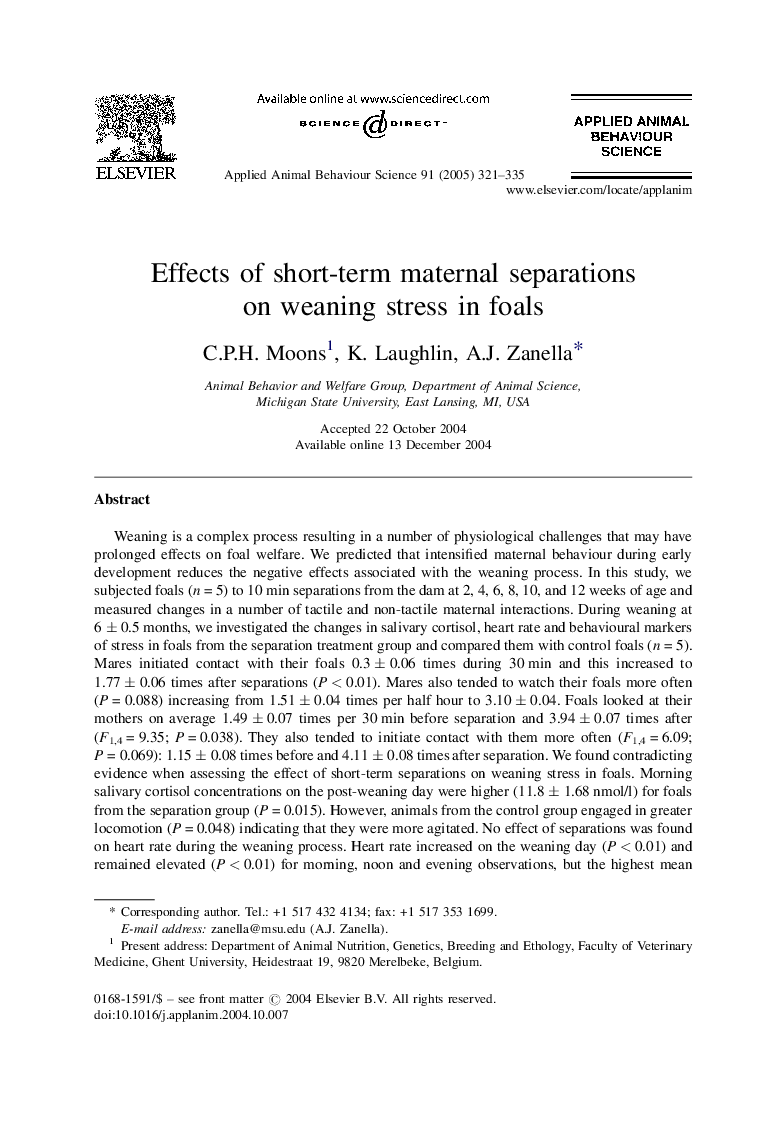| کد مقاله | کد نشریه | سال انتشار | مقاله انگلیسی | نسخه تمام متن |
|---|---|---|---|---|
| 9475939 | 1625457 | 2005 | 15 صفحه PDF | دانلود رایگان |
عنوان انگلیسی مقاله ISI
Effects of short-term maternal separations on weaning stress in foals
دانلود مقاله + سفارش ترجمه
دانلود مقاله ISI انگلیسی
رایگان برای ایرانیان
کلمات کلیدی
موضوعات مرتبط
علوم زیستی و بیوفناوری
علوم کشاورزی و بیولوژیک
علوم دامی و جانورشناسی
پیش نمایش صفحه اول مقاله

چکیده انگلیسی
Weaning is a complex process resulting in a number of physiological challenges that may have prolonged effects on foal welfare. We predicted that intensified maternal behaviour during early development reduces the negative effects associated with the weaning process. In this study, we subjected foals (n = 5) to 10 min separations from the dam at 2, 4, 6, 8, 10, and 12 weeks of age and measured changes in a number of tactile and non-tactile maternal interactions. During weaning at 6 ± 0.5 months, we investigated the changes in salivary cortisol, heart rate and behavioural markers of stress in foals from the separation treatment group and compared them with control foals (n = 5). Mares initiated contact with their foals 0.3 ± 0.06 times during 30 min and this increased to 1.77 ± 0.06 times after separations (P < 0.01). Mares also tended to watch their foals more often (P = 0.088) increasing from 1.51 ± 0.04 times per half hour to 3.10 ± 0.04. Foals looked at their mothers on average 1.49 ± 0.07 times per 30 min before separation and 3.94 ± 0.07 times after (F1,4 = 9.35; P = 0.038). They also tended to initiate contact with them more often (F1,4 = 6.09; P = 0.069): 1.15 ± 0.08 times before and 4.11 ± 0.08 times after separation. We found contradicting evidence when assessing the effect of short-term separations on weaning stress in foals. Morning salivary cortisol concentrations on the post-weaning day were higher (11.8 ± 1.68 nmol/l) for foals from the separation group (P = 0.015). However, animals from the control group engaged in greater locomotion (P = 0.048) indicating that they were more agitated. No effect of separations was found on heart rate during the weaning process. Heart rate increased on the weaning day (P < 0.01) and remained elevated (P < 0.01) for morning, noon and evening observations, but the highest mean heart rate was 86.57 ± 1.05 heart beats per minute (BPM), immediately after weaning. All parameters we measured showed a significant day by time interaction characterizing the weaning process. Fillies walked more after weaning, especially during noon (13.81 ± 1.21 min) and afternoon (11.73 ± 1.21 min) observations (P < 0.01). They also laid down less (P = 0.032; 1.73 ± 1.89 min) than colts (9.79 ± 2.35 min) and on the post-weaning day, the morning cortisol concentrations were higher in fillies (22.24 ± 1.56 nmol/l; P < 0.01). In the discussion, we argue based on the contradicting evidence that we cannot draw a definite conclusion regarding the effect of early-life separations on stress-coping strategies in foals but we propose changes for future research. Finally, we discuss the results pertaining to gender-related differences.
ناشر
Database: Elsevier - ScienceDirect (ساینس دایرکت)
Journal: Applied Animal Behaviour Science - Volume 91, Issues 3â4, June 2005, Pages 321-335
Journal: Applied Animal Behaviour Science - Volume 91, Issues 3â4, June 2005, Pages 321-335
نویسندگان
C.P.H. Moons, K. Laughlin, A.J. Zanella,